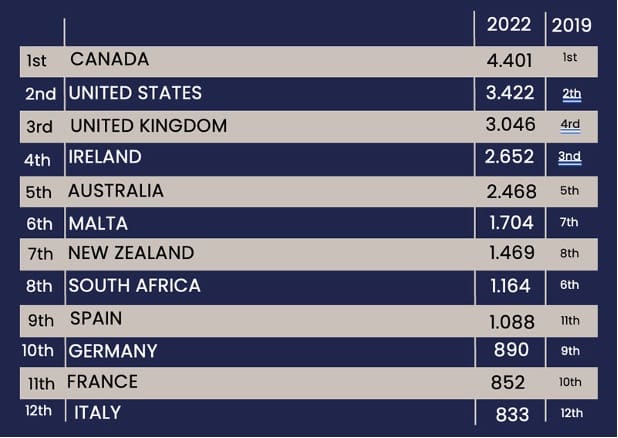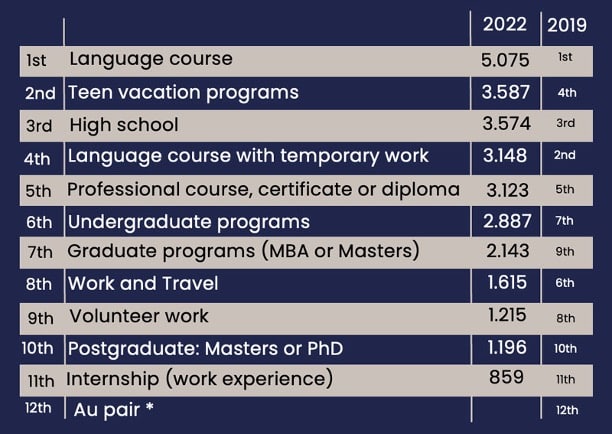Outbound mobility trends for key Latin markets: Brazil, Colombia, Mexico
- Brazilian, Colombian, and Mexican students are more enthusiastic than ever about study abroad – and Canada is extremely popular in these markets
- Australia is also welcoming more students from Latin America than before the pandemic
We recently looked at outbound mobility trends in five top student markets in Asia: Bangladesh, Nepal, Pakistan, Philippines, and Thailand. We found that there are now many more students from Southeast Asia travelling abroad for their studies than in 2020.
This time, we turn to the Americas: Brazil, Colombia, and Mexico. These countries, and the region in general, account for some of the most remarkable recent increases in students for major destinations – particularly Canada.
We use 2020 UNESCO data on tertiary outbound mobility as our baseline, then factor in more recent data from government sources in leading destinations (Australia, Canada, US) where available to see how mobility is trending in 2022. Please note: Australian, Canadian, and US data includes enrolments in other sectors as well as higher education.
Students from Brazil, Colombia, and Mexico of course go to other countries as well, but our focus here is on destinations enrolling more than 2,000 students from these countries.
Brazil
The most recent UNESCO data (2020) counts 89,150 Brazilian students abroad in higher education. This number is likely higher today if we go on the basis of rapid growth in student numbers in Australia and Canada in particular – some of which will be in the higher education sector. There were 30% more Brazilian students at all levels/types of education in Australia in 2022 than in 2021, and Canada registered the same percentage increase. Numbers have not grown as significantly in the US.
- Argentina: 20,515 in 2020 (UNESCO)
- Australia: 19,055 in 2022 (+30% y-o-y)
- Portugal: 18,080 in 2020 (UNESCO)
- Canada: 14,465 in 2022 (+30%)
- US: 14,895 in 2021/22 (+6%)
- France: 5,435 in 2021/22 (+7%) according to Campus France
- Germany: 4,670 (UNESCO)
- Spain: 2,070 (UNESCO)
Many Brazilian students travel abroad for language programmes. In 2022, a BELTA survey found that the top preferences for Brazilian language students were Canada, the United States, UK, Ireland, and Australia. Here’s an astounding bit of information: the Brazilian embassy in Ireland estimates that the number of Brazilian students in Ireland rose from 13,600 in 2016 to 70,000 in 2021.
While language studies are the most popular option for Brazilian students, the survey also found that more Brazilian students are considering university studies abroad. As the second chart (below) indicates, undergraduate programmes moved from 7th place in 2019 to 6th place in 2022 in terms of their popularity, and graduate programmes moved from 9th to 7th.


Colombia
The most recent UNESCO data (2020) counts 34,780 Colombian students abroad in higher education. Colombian student outbound is more degree-oriented than is the case in Brazil or Mexico, though many Colombian students take a language course to prepare them for their degree programme. Given this feature of the Colombian market, we can assume that Australian, Canadian, and the US universities – as well as language programmes – were seeing many more Colombian students in 2022 than in 2021.
Canada has seen dramatic growth from the Colombian market. The number of Colombian students in Canada in 2022 (12,440) was 123% higher than in 2019, when there were only 5,580 students. By contrast, Australian institutions welcomed 7% more Colombian students and US institutions hosted 4% more students over that same time frame (2019–2022).
- Australia: 22,260 in 2022 (+52% y-o-y)
- Spain: 16,460 in 2019/20 according to the Spanish government
- Argentina: 13,480 in 2020 (UNESCO)
- Canada: 12,440 in 2022 (+54%)
- US: 8,075 in 2021/22 (+14%)
- Germany: 3,530 in 2020 (UNESCO)
- Chile: 2,465 in 2020 (UNESCO)
- Ecuador: 2,170 in 2020 (UNESCO)
Mexico
The most recent UNESCO data (2020) counts 56,910 Mexican students abroad in higher education. Since then, more Mexicans have opted to study abroad, and Canada, again, is rising in popularity. Canadian institutions welcomed 30% more Mexicans in 2022 than in 2021, and growth is even more significant compared with 2019. That year, there were only 8,670 Mexican students in Canada – the jump in 2022 to 14,930 represents a 72% increase over the span of three years. By contrast, the US recorded only a 1% increase and the number of Mexican students in Australia fell by 30% over the three years from 2019 to 2022.
- Canada: 14,930 in 2022 (+30% y-o-y)
- US: 14,500 in 2021/22 (+12%)
- Spain: 8,475 in 2019/20 according to the Spanish government
- France: 2,258 in 2020 (UNESCO)
- Australia: 2,160 (+67%)
- Germany: 3,450 in 2020 (UNESCO)
Canada's big push in Latin America
Clearly, Canadian institutions have intensified their recruiting in Brazil, Colombia, and Mexico. But the focus is wider than that – the entire Latin and South American region is sending many more students to Canada than before. For example:
- Peru: 4,025 in 2022 (+114% y-o-y) – up 289% since 2019
- Ecuador: 2,550 in 2022 (+33%) – up 80% since 2019
- Chile: 1,990 in 2022 (+30%) – up 169% since 2019
- Trinidad and Tobago: 1,000 (+32%) – up 34% since 2019
- Argentina: 870 (+30%) – up 117% since 2019
- Bolivia: 370 (+37%) – up 147% since 2019
While some of those numbers may seem small – especially compared with the tens of thousands of students from Canada’s top five markets – they are significant and reflect a surge of popularity for Canada in Latin and South America. Many of the markets more than doubled in size for Canada over the span of just three years. The larger bases of students from each country now could provide the basis for an even stronger growth trajectory – provided the current cohort enjoys their experience in Canada and conveys their satisfaction to peers at home.
Canada’s Student Direct Stream (SDS) – an expedited study permit processing programme for students from certain countries applying to study at a Canadian post-secondary institution – may be part of the reason that Canada is outperforming other top destinations. Of the 14 countries on the SDS list, seven are in Latin/South America or the Caribbean: Antigua and Barbuda, Brazil, Colombia, Costa Rica, Peru, Saint Vincent and the Grenadines, and Trinidad and Tobago.
Australia is also increasing its efforts in the region
Australian institutions also seem to have their sights set on South and Latin America in their diversification strategies. A March 2023 Austrade briefing indicates significant investment in the region, with key activities centring on events and student fairs, scholarships, and loans. Austrade notes that Colombia "has become a focal point for institutions appointing staff in the region." In 2022, Austrade launched a Study Australia Experience website aimed at the Latin American market, with content translated into Spanish and Portuguese. The overarching goal of the initiative is to help participating Australian institutions (33 in total) to increase enrolments from Argentina, Brazil, Chile, Colombia, Peru and Mexico. The website is part of a multi-channel effort that also involves school representatives, social media, agents, and online events.
For additional background, please see:
Most Recent
-
ICEF Podcast: Together for transparency – Building global standards for ethical international student recruitment Read More
-
New analysis sounds a note of caution for UK immigration reforms Read More
-
The number of students in higher education abroad has more than tripled since the turn of the century Read More
















